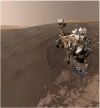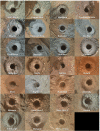Mission Overview and Scientific Contributions from the Mars Science Laboratory Curiosity Rover After Eight Years of Surface Operations
- PMID: 35399614
- PMCID: PMC8981195
- DOI: 10.1007/s11214-022-00882-7
Mission Overview and Scientific Contributions from the Mars Science Laboratory Curiosity Rover After Eight Years of Surface Operations
Abstract
NASA's Mars Science Laboratory mission, with its Curiosity rover, has been exploring Gale crater (5.4° S, 137.8° E) since 2012 with the goal of assessing the potential of Mars to support life. The mission has compiled compelling evidence that the crater basin accumulated sediment transported by marginal rivers into lakes that likely persisted for millions of years approximately 3.6 Ga ago in the early Hesperian. Geochemical and mineralogical assessments indicate that environmental conditions within this timeframe would have been suitable for sustaining life, if it ever were present. Fluids simultaneously circulated in the subsurface and likely existed through the dry phases of lake bed exposure and aeolian deposition, conceivably creating a continuously habitable subsurface environment that persisted to less than 3 Ga in the early Amazonian. A diversity of organic molecules has been preserved, though degraded, with evidence for more complex precursors. Solid samples show highly variable isotopic abundances of sulfur, chlorine, and carbon. In situ studies of modern wind-driven sediment transport and multiple large and active aeolian deposits have led to advances in understanding bedform development and the initiation of saltation. Investigation of the modern atmosphere and environment has improved constraints on the timing and magnitude of atmospheric loss, revealed the presence of methane and the crater's influence on local meteorology, and provided measurements of high-energy radiation at Mars' surface in preparation for future crewed missions. Rover systems and science instruments remain capable of addressing all key scientific objectives. Emphases on advance planning, flexibility, operations support work, and team culture have allowed the mission team to maintain a high level of productivity in spite of declining rover power and funding.
Supplementary information: The online version contains supplementary material available at 10.1007/s11214-022-00882-7.
Keywords: Astrobiology; Climate; Geology; Mars; Meteorology; Planets.
© The Author(s) 2022.
Conflict of interest statement
Conflicts of interest/Competing interestsThe author has no relevant financial or non-financial interests to disclose.
Figures












References
-
- Abbey W., Anderson R., Beegle L., Hurowitz J., Williford K., Peters G., Morookian J.M., Collins C., Feldman J., Kinnett R., Jandura L., Limonadi D., Logan C., McCloskey S., Melko J., Okon A., Robinson M., Roumeliotis C., Seybold C., Singer J., Warner N. A look back: the drilling campaign of the Curiosity rover during the Mars Science Laboratory’s Prime Mission. Icarus. 2019;319:1–13. doi: 10.1016/j.icarus.2018.09.004. - DOI
-
- Abbey W., Anderson R., Beegle L.W., Peters G., Morookian J.M., Biesiadecki J., Carsten J., Collins C., Davis K., Kinnett R., Klein D., Kuhn S., Logan C., Maimone M., Melko J., Okon A., Reid J., Robinson M., Singer J., Verma V., Vasavada A.R. A look back, part II: the drilling campaign of the Curiosity rover during the Mars Science Laboratory’s second and third Martian years. Icarus. 2020;350:113885. doi: 10.1016/j.icarus.2020.113885. - DOI
-
- Achilles C.N., Downs R.T., Ming D.W., Rampe E.B., Morris R.V., Treiman A.H., Morrison S.M., Blake D.F., Vaniman D.T., Ewing R.C., Chipera S.J., Yen A.S., Bristow T.F., Ehlmann B.L., Gellert R., Hazen R.M., Fendrich K.V., Craig P.I., Grotzinger J.P., Des Marais D.J., Farmer J.D., Sarrazin P.C., Morookian J.M. Mineralogy of an active eolian sediment from the Namib dune, Gale crater, Mars. J. Geophys. Res., Planets. 2017;122:2344–2361. doi: 10.1002/2017JE005262. - DOI
-
- Achilles C.N., Rampe E.B., Downs R.T., Bristow T.F., Ming D.W., Morris R.V., Vaniman D.T., Blake D.F., Yen A.S., McAdam A.C., Sutter B., Fedo C.M., Gwizd S., Thompson L.M., Gellert R., Morrison S.M., Treiman A.H., Crisp J.A., Gabriel T.S.J., Chipera S.J., Hazen R.M., Craig P.I., Thorpe M.T., Des Marais D.J., Grotzinger J.P., Tu V.M., Castle N., Downs G.W., Peretyazhko T.S., Walroth R.C., Sarrazin P., Morookian J.M. Evidence for multiple diagenetic episodes in ancient fluvial-lacustrine sedimentary rocks in Gale crater, Mars. J. Geophys. Res., Planets. 2020;125:e2019JE006295. doi: 10.1029/2019JE006295. - DOI - PMC - PubMed
-
- Achilles C.N., Morris R.V., Rampe E.B., Gabriel T.S.J., Ming D.W., Sutter B., Chipera S.J., Blake D.F., Bristow T.F., McAdam A.C., Downs R.T., Vaniman D.T., Yen A.S. Lunar and Planetary Science Conference. 2021. Factors influencing the formation and preservation of X-ray amorphous materials identified in sedimentary deposits at Gale crater, Mars.
Publication types
LinkOut - more resources
Full Text Sources
Miscellaneous
